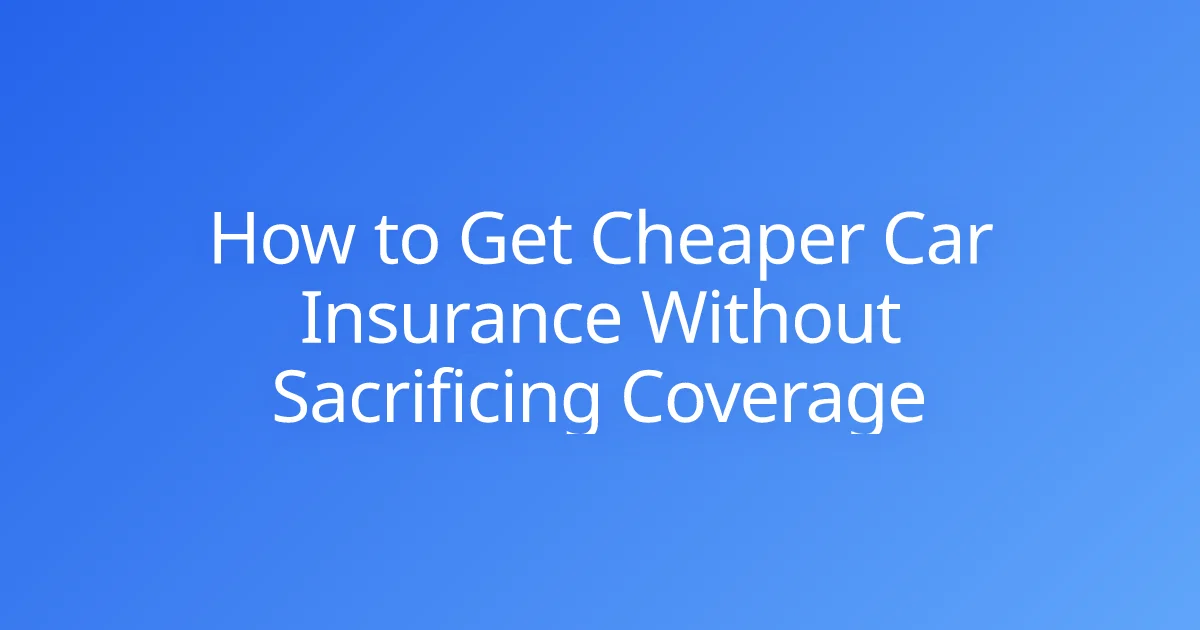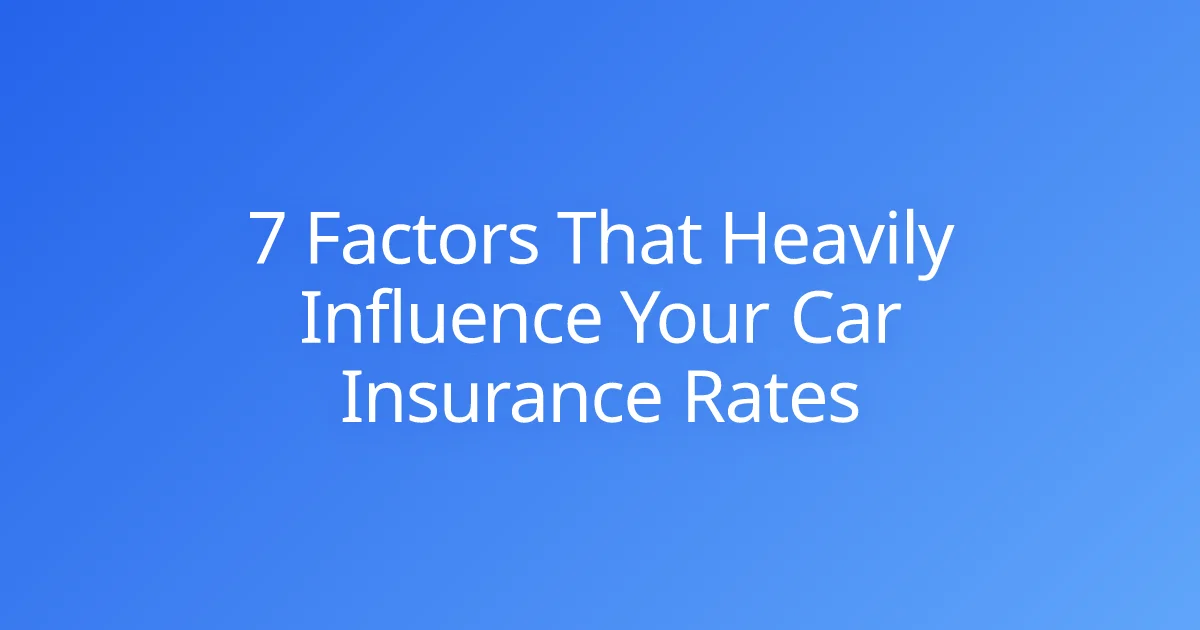How to Get Cheaper Car Insurance Without Sacrificing Coverage
Are you constantly feeling the pinch of high car insurance rates? Many drivers grapple with this financial burden, often wondering if the only way to lighten it is by slashing their coverage and leaving themselves vulnerable on the road. The idea of getting cheaper car insurance without sacrificing coverage might seem like a pipe dream, but it's entirely achievable with the right strategies. Ignoring this challenge can lead to overpaying by hundreds, if not thousands, of dollars annually, or, worse, being dangerously underinsured when an accident occurs.
At The Policy Explainer, we believe that smart financial planning includes optimizing your insurance costs. This comprehensive guide will empower you with expert, actionable strategies to significantly lower your car insurance rates without compromising the vital protection you need. We'll show you how to navigate the factors influencing your premiums and unlock legitimate savings, ensuring you drive with confidence and a healthier bank account.
Understanding What Influences Your Car Insurance Rates
Before diving into savings strategies, it's essential to grasp the core factors that influence your car insurance rates. Insurers assess risk based on various data points about you, your vehicle, and your driving habits. Your premium is a reflection of this calculated risk.
Key factors include:
- Your Driving Record: Accidents, tickets, and violations signal higher risk.
- The Type of Vehicle You Drive: Cost of repairs, safety ratings, and theft rates of your car.
- Your Location: Urban vs. rural areas, crime rates, and weather patterns.
- Your Age and Driving Experience: Younger, less experienced drivers typically pay more.
- Your Deductible Amount: The higher your deductible, the lower your premium.
- Your Credit History: In many states, a good credit-based insurance score can lead to lower rates.
- Coverage Levels Chosen: Higher limits and more types of coverage naturally increase premiums.
By understanding these elements, you can strategically influence your rates.
Smart Strategies to Lower Your Car Insurance Premiums
Now, let's explore the practical ways to get cheaper car insurance without cutting essential protection.
Optimize Your Coverage and Deductibles
One of the most direct ways to impact your premium is by intelligently adjusting your policy's structure.
- Increase Your Deductible: Your deductible is the amount you pay out-of-pocket before your collision or comprehensive coverage kicks in. Choosing a higher deductible (e.g., from $500 to $1,000 or $2,500) directly reduces your premium because you're taking on more initial financial responsibility.
- Action: Ensure you have enough in your emergency fund to comfortably cover this higher deductible if a claim arises. Don't increase it if you can't afford it.
- Review and Adjust Coverage Levels:
- Liability Limits: While state minimums are cheap, they rarely offer enough protection. Do not reduce your liability limits if you have significant assets to protect. Instead, ensure they are adequately high (e.g., $100,000/$300,000 bodily injury and $50,000/$100,000 property damage).
- Collision & Comprehensive for Older Cars: If your car is more than 10-15 years old and its market value is low (e.g., less than $3,000 - $5,000), consider if the cost of collision and comprehensive premiums (plus your deductible) is worth the potential payout. You might save more by self-insuring against damage to the vehicle itself, especially if you could replace it easily.
- Action: Regularly assess your vehicle's current market value and compare it to the annual cost of these coverages.
Maximize Every Discount Available
Insurance companies offer a surprising number of discounts, many of which go unclaimed. Always ask your insurer or agent about every discount you might qualify for.
- Bundling Policies: Insuring your auto and home (or renters/condo) insurance with the same provider often qualifies you for a significant multi-policy discount, typically 5-25% off your total premium.
- Action: Get quotes for bundling, but also get separate quotes from other insurers to ensure the bundled price is truly the best overall deal.
- Multi-Vehicle Discount: If you insure more than one car on the same policy, you'll usually receive a discount.
- Safe Driver / Good Driver Discounts:
- Clean Record: Maintain a history free of accidents or tickets.
- Defensive Driving Course: Completing an approved course can sometimes reduce rates, especially for young drivers or those with minor infractions.
- Telematics/Usage-Based Insurance (UBI) Programs: Allow your insurer to track your driving habits (e.g., via a smartphone app or device). Safe driving (lower speeds, less harsh braking) can lead to significant discounts.
- Vehicle Safety Features Discounts: For cars equipped with anti-lock brakes (ABS), airbags, anti-theft devices, automatic seat belts, or even newer advanced driver-assistance systems (ADAS).
- Payment & Policy Discounts:
- Paid-in-Full Discount: Paying your entire annual premium upfront instead of monthly installments can save money.
- Auto-Pay/Paperless Billing: Enrolling in automatic payments or opting for electronic documents.
- Good Student Discount: For young drivers (usually under 25) who maintain a certain GPA.
- Occupational/Affiliation Discounts: Some insurers offer discounts for members of certain professions (e.g., teachers, engineers, military) or alumni associations.
Improve Your Driver Profile
Some factors influencing your rates are within your direct control, even if they take time.
- Maintain a Clean Driving Record: This is arguably the most impactful long-term strategy. Each year you drive without accidents or violations, your risk profile improves, leading to lower premiums.
- Action: Practice safe driving habits. If you get a minor ticket, consider if a defensive driving course could prevent points on your record.
- Avoid Small Claims: For very minor damage (e.g., less than $1,000) that's only slightly above your deductible, consider paying out-of-pocket instead of filing a claim. Frequent small claims can signal higher risk to insurers and potentially lead to higher premiums or even non-renewal.
- Improve Your Credit Score (where applicable): In most U.S. states, insurers use credit-based insurance scores. A higher score is often correlated with lower insurance claims, leading to better rates.
- Action: Pay your bills on time, reduce debt, and regularly check your credit report for errors.
Drive Less or Differently
Your driving habits can also influence your rates.
- Low Mileage Discounts: If you work from home, use public transportation, or have a short commute, you might qualify for a discount. Some insurers offer programs for those who drive below a certain annual mileage threshold.
- Usage-Based Insurance (UBI): As mentioned, these programs monitor your actual driving behavior. If you're a consistently safe driver, you can earn substantial discounts.
- Consider Carpooling or Public Transit: Reducing your daily driving time directly reduces your exposure to risk, which can be reflected in your rates.
Shop Around Regularly and Compare Smartly
This is perhaps the most crucial strategy, as rates vary significantly between insurers.
- Get Multiple Quotes: Never settle for just one or two quotes. Contact at least 3-5 different insurers (national carriers, regional companies, and independent agents) to compare offers.
- "Apples-to-Apples" Comparison: Crucially, ensure that every quote you receive offers the exact same coverage limits, deductibles, and any specific endorsements you need. A lower premium on one quote might simply mean less coverage.
- Utilize Independent Agents: These agents work with multiple insurance companies, allowing them to shop around on your behalf to find the best rates and coverage that fit your needs without you having to contact each insurer individually.
- Review Annually (or More Often): Make it a habit to review your car insurance policy and shop for new quotes every 6-12 months, or at least at every renewal period. Your life changes, and so do market rates and insurer offerings.
- Don't Be Afraid to Switch: If a new insurer offers better value, don't hesitate to switch. The process is often simpler than you think.
What "Without Sacrificing Coverage" Really Means
The goal of getting cheaper car insurance is not to leave yourself exposed. "Without sacrificing coverage" means:
- Adequate Liability Protection: Ensuring your bodily injury and property damage liability limits are high enough to protect your assets from a major lawsuit, far exceeding state minimums.
- Protection for Your Vehicle: Maintaining collision and comprehensive coverage if your vehicle's value warrants it, or if it's financed.
- Closing Gaps: Adding crucial coverages like Uninsured/Underinsured Motorist (UM/UIM) protection, which is essential in many states to shield you from other drivers' lack of insurance.
- Tailoring to Your Needs: Ensuring your policy truly fits your specific risks and lifestyle, rather than being a generic, insufficient plan.
It's about being strategic and informed, not just cutting corners.
Conclusion
Getting cheaper car insurance without sacrificing coverage is a realistic and attainable goal for every driver. By understanding the underlying factors that heavily influence your car insurance rates and proactively implementing smart strategies—from optimizing your policy structure and maximizing discounts to improving your driver profile and regularly shopping around—you can significantly reduce your premiums.
Don't let the complexity of auto insurance lead to overpaying or under-protecting your valuable assets. Armed with this knowledge, you are empowered to make informed decisions that secure robust coverage at the most competitive price, ensuring financial peace of mind on every journey. Do you have specific questions about a certain discount, or perhaps a unique driving situation you're trying to optimize for lower rates?



